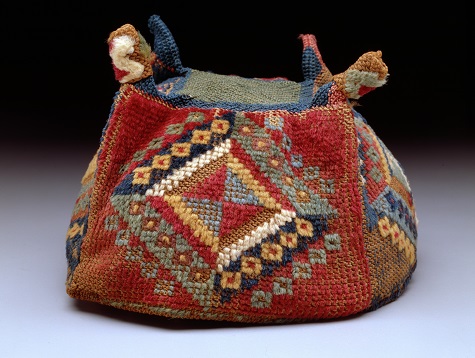For thousands of years, artists in the Andean region of South America have been weaving beautiful and complex textiles—an extremely labor intensive process as well as an important form of artistic expression. Beyond serving as protection from the arduous cold of the highlands and the intense sun of the Andean coast, textiles played important roles in ritual, political, and social life and functioned as a marker of social identity for both the living and the dead. Because it took so much time and effort to produce a textile, wearing a highly decorative tunic, for example, conveyed the wearer’s social prestige. Today, we are surrounded by textiles—from the upholstery of our living room sofas to our clothes and bed sheets. But most of today’s textiles were created in mass and for the masses.
One of the goals of Inca: Conquests of the Andes—on view until November 15, 2015—is to emphasize that each of the textiles in the exhibition was laboriously and thoughtfully created by hand. So, we designed a space within its galleries to illustrate the step-by-step process of making a textile, from the shearing of a camelid for natural hair or the picking of raw cotton, to the many specific ways that fibers can be woven together to produce a textile.
We were thrilled to collaborate on this project with University of North Texas professor Lesli Robertson and the awesome students in her class Topics in Fiber: Community, Culture, and Art. To kick it off, the class visited the DMA’s textile storage and examined fragments representing a variety of weaving techniques for inspiration. Then, they returned to campus and got busy creating enlarged samples of the weaving techniques, using extra strong and thick cording and string so that visitors can touch and feel the nuanced differences between the various techniques. The students experimented with natural dyes like indigo and cochineal (a parasitic insect) to produce bright colors, mirroring the Andean artists in the exhibition. They also produced a backstrap loom—a small, portable loom popular in the Andes that is attached around the weaver’s back and anchored to a tree or other high post. Be sure to check out the students’ photodocumentation of their project on Instagram. They tagged all of their photos and video with #IncaConquestUNT.
Better yet, visit the Inca exhibition and explore the sample wall to learn about the intricate weaving processes used by the artists represented in the exhibition. When you enter, grab a Weaving Techniques guide from the holder. The colorful round icons on labels indicate the predominant weaving technique used for that artwork. Look for differences in the techniques in the artwork galleries, but try to feel the difference in the Weaving in the Andes space.
Andrea Severin Goins is the Interpretation Manager at the DMA.









